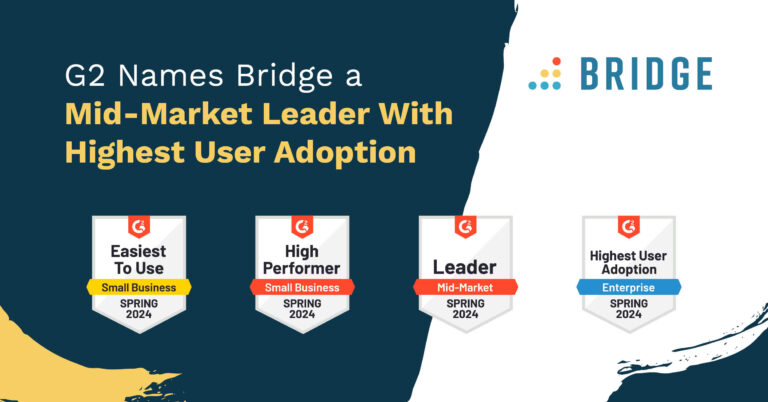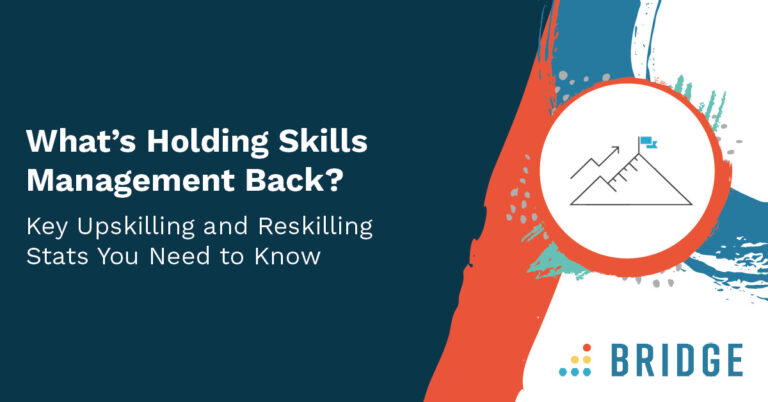Did you know that Millennials who plan to stay with an organization for more than five years are twice as likely to have a mentor (68%) than not (32%)? For enterprise organizations, though, one of the main issues in providing a strong mentorship program is the burden on HR to facilitate. Offering people a self-service mentor marketplace—one that allows them to quickly and organically create connections and relationships with others in the business—takes this burden off HR professionals.
Read on to find out more about workplace mentoring, including:
- What is mentorship and why it’s important?
- Mentorship models and processes
- Where to find a mentor
- How to create a successful mentorship program
What Is Mentorship?
Mentorship is the ability to use your knowledge, skills, and experiences in order to provide context for someone who is interested in pursuing a role or career similar to yours. Or, perhaps they’re simply wanting to build similar skills as you, the mentor.
Ideally, mentorship should be viewed as an opportunity for employees to build new skills in the spirit of growing their careers with the organization. When developed thoughtfully and intentionally, mentorship programs can be a powerful tool in recruiting and retaining employees.
What Is e-Mentoring?
E-mentoring is a means of providing a guided mentoring relationship using online software or email. This approach to mentoring allows mentors and mentees to communicate informally and without physical location or time zones becoming roadblocks. The key to achieving a high level of engagement is the ability to streamline the process through the use of AI.
A winning talent experience will facilitate e-Mentoring seamlessly, in a self-service manner, and allow HR professionals to focus on other endeavors. And, it helps your organization provide an exceptional talent mobility experience.
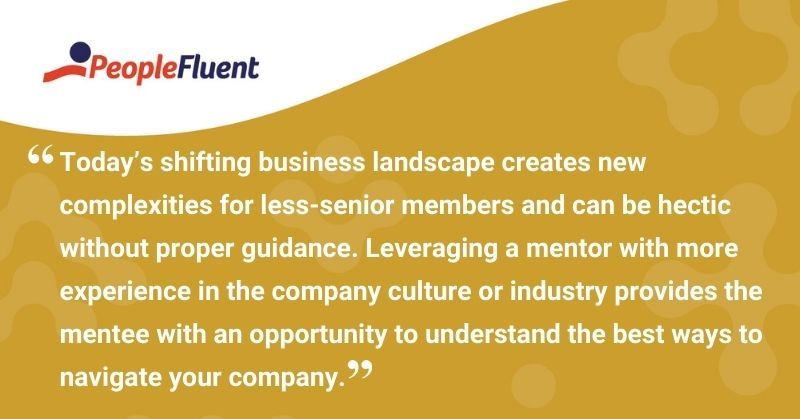
Why Is Mentoring Important?
Today’s shifting business landscape creates new complexities for less-senior members and can be hectic without proper guidance. Leveraging a mentor with more experience in the company culture or industry can make a world of difference. This provides the mentee with an opportunity to understand the best ways to navigate your company while providing a much-needed confidence boost.
Picture this: a new recruit is hired straight out of college and has the necessary hard skills to perform the job. However, they may be lacking in soft skills such as communication or networking. This can be frustrating for a young professional who has the potential to become a top performer but may experience setbacks due to inexperience. Developing a mentor-mentee relationship to solve these roadblocks is just one reason why mentoring is important in the workplace.
Mentoring will bring value at several levels for the organization as well as mentors and mentees alike. A strong mentorship program will give mentees a way to gain practical experience and knowledge. Additionally, it will give mentors an opportunity to expand their own professional knowledge or skills while mentoring others—great building blocks of a successful talent leader.
RECOMMENDED READ | ‘Rise of the Modern Talent Journey: Mapping the New Employee Experience’
What Is a Successful Mentoring Process?
While we stress the importance of keeping mentorship engagements informal, it’s still critical to have a general process that mentors and mentees can follow. The following phases of a mentoring process might be:
1) Planning phase: This is where a mentee decides they would like to be mentored and begins searching for a mentor. The planning phase is also a good time for mentees to think about what type of mentorship model they want to follow.
2) Initiation phase: The mentor and mentee have agreed on a mentorship engagement and are building a relationship as well as developing their timeframe and goals.
3) Mentoring phase: By this time, the mentor and mentee are meeting on a regular basis and are working on achieving goals. This can be as often as every week or every other month and varies depending on the type of mentorship model agreed on at the start of the relationship.
4) Evaluation phase: At this point, the mentee and mentor can decide on whether they’d like to continue a mentorship relationship or if the mentor is ready to move on. This is a great opportunity for the mentee to discuss what worked (and what didn’t) and for the mentor to provide feedback to the mentee.
RELATED READING | ‘Do You Know How to Find the Bright Lights in Your Organization?’
How Long Should a Mentorship Program Be?
Ultimately, the length of a mentorship program depends on the category or type of mentorship that the mentor is open to, and that the mentee is interested in. Traditional mentorship programs rely heavily on a structured approach with a predetermined time frame for completion.
As mentioned above, traditional mentoring programs were facilitated by an HR professional rather than the informal manner in which we believe a mentorship program should be conducted.
Knowing that timeframes will fluctuate depending on the type of mentorship program, consider this: a skills-based mentorship can last anywhere from one to six months while an informal mentoring engagement could simply include a few chats between mentor and mentee. The length of mentoring engagements will inevitably depend on the company culture, how it evolves, and the mentee’s goals.
MORE FROM THE BLOG | ‘Learning and Talent Mobility: A Winning Combination to Drive Employee Retention and Results’
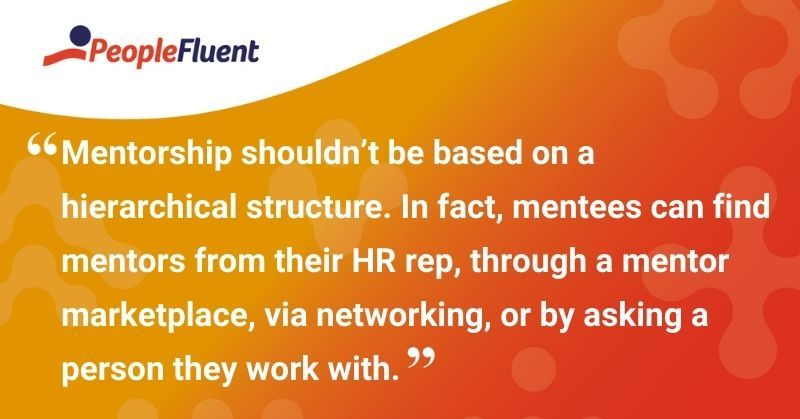
Where Can You Find a Mentor?
In theory, mentorship shouldn’t be based on a hierarchical structure, especially as there’s a more recent concept of reverse mentoring. For clarity, reverse mentoring is when a junior employee mentors senior executives in a large organization. This newer concept has emerged over the past five years or so as Millennials have entered the workplace. As this younger generation is more digitally savvy, they are able to help senior executives bridge the digital gap.
Mentees can find mentors from their HR rep, through self-service means (like the mentor marketplace), via networking, or by asking a person they work with. For example, let’s say John wants to move from his role in technical recruiting to an account management role.
While these two roles may require similar skills, John needs to brush up on certain skills that the hiring manager is looking for in a candidate. Through discussing this with a colleague, John finds that there’s an account manager who is willing to mentor him—allowing John to build on the skills he needs to progress in his career.
Pro tip: AI-driven mentor marketplaces simplify the matching and pairing process for mentors and mentees, at scale. Going further, they enhance the ability for reverse mentoring as senior executives can now request mentorship based on skills they want to learn from the junior talent within their organizations.
What Are the Different Types of Mentoring?
While traditional mentoring models include one-on-one, distance (or virtual) mentoring, and group mentoring, the way we work is changing. With the many changes facing our workforces, HR professionals no longer have time to focus on scheduling these mentoring programs. Nor is it advisable to have a talent manager focus on keeping track of goals or taking notes on topics discussed during a mentoring session.
Leveraging an AI-driven, personalized mentor marketplace can elicit big wins and leave your HR professionals freed up for more pressing matters. Below are the ideal types of mentoring for today’s busy workers:
1) Networking
In this type of mentoring, a sales professional might be interested in learning more about marketing. The sales rep would then seek out and speak to a member of the marketing team on an informal basis, like instant messaging tools.
2) Career Track
This is when a mentee is actively aspiring to reach a specific role that puts them on track to progress in their career. The mentee spends time with a mentor, focused on discussing their career and what they want to gain from the mentor. That end-goal could be learning new skills, knowledge, or experience that allows them to achieve career development.
3) Skills-Based
When a mentee is looking to hone their skills, the skills-based scenario allows them to raise their hand and be matched with a mentor. So long as the mentor accepts, the mentee will work toward learning a new skill or skills that will help empower them to take ownership of their personal talent journey within the organization.
According to recent research, 83% of employers now say the shift to remote work has been successful for their company. With that, remote work has and will continue to change how the mentorship landscape shifts from formal to informal. This means that companies must focus on offering mentorship programs that are targeted and personalized to the mentee as well as the mentor.
YOU MIGHT ALSO LIKE | ‘5 Things HR Pros Can Do to Ensure a Modern Talent Journey’
What’s The Difference Between Mentoring and Coaching?
Mentoring and coaching were created, in essence, for the same reason: developing people to help them reach their full potential. While it may seem like they’re the same thing, the two have many differences when put into practice.
Mentoring has always been more historical, informal, and based on knowledge-sharing. It is heavily based on passing down knowledge to others with the end-goal often being unique to the mentee. Mentoring can be short-term or long-term, though the best results are often achieved through an ongoing process.
Typically, mentoring is a voluntary program where mentors and mentees seek one another out informally via personal or professional networks. A mentor’s main focus should be on listening, learning, and then offering advice in order to point the mentee in the proper direction. In this regard, the difference between mentoring and coaching is that the former relies on relationship-driven guidance rather than the latter’s formal, structured approach.
Coaching, on the other hand, is results-focused and short-term. A career coach will focus on training and upskilling rather than offering guidance based on personal/professional experience. In fact, a career coach will likely not have industry knowledge or experience, making this one of the key differences between mentoring and coaching.
Finally, mentoring is a mentee-driven process that requires the mentee to be responsible for and dedicated to their own progress. Coaching, on the other hand, is led by the coach and there’s more expectation on them to lead the sessions and achieve desired results.
READ MORE | ‘Upskilling vs. Reskilling: Understanding the Differences and Their Role in Talent Mobility’
What’s the Difference Between an Apprenticeship and Business Mentorship?
The difference between an apprenticeship and business mentorship is that an apprenticeship is typically geared toward skilled workers (or trade workers). In an apprenticeship, the mentor and learner typically have a professional relationship, whereas a mentor and mentee may not know each other professionally.
Mentorship focuses on mentors sharing their experiences and professional skills to help mentees learn from them and grow their careers, or learn new skills. This can also be an opportunity for the mentor to share mistakes or missteps they’ve made along the way.
An apprenticeship will be a more structured approach where the mentor trains people while also completing the tasks and responsibilities of their role. In addition to receiving this on-the-job training, an apprentice will also gain real-life knowledge and experience.
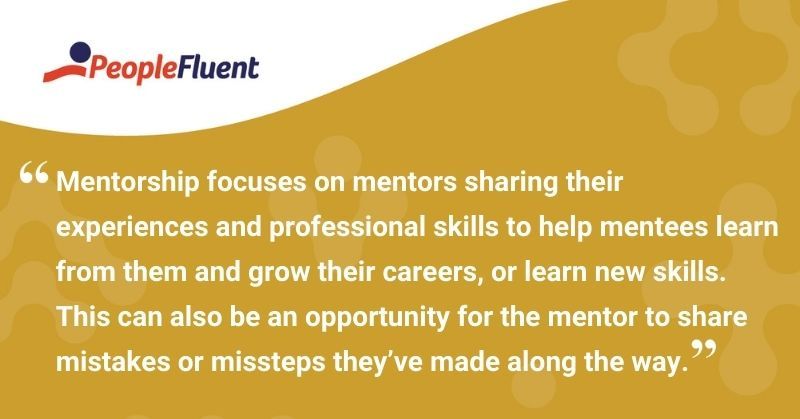
How Mentoring Helps Employees
With research suggesting that 91% of workers who have a mentor are happy with their careers, the benefits of mentorship for employees are abundant. In particular, these benefits to the mentee can also elicit success for the organization:
- Increased organizational knowledge into how the company works
- Greater awareness of different approaches to working
- The ability to overcome challenges with the help of a confidential sounding board (the mentor)
- An increase in confidence and more professional development opportunities
How Mentoring Benefits the Mentor
A successful mentorship program can have lasting benefits for the mentee, mentor, and the organization all at once. Some of the benefits for mentors are:
- New ways of thinking or solving problems that may not have been considered before
- An increase in the mentor’s self-confidence
- The ability to give and receive feedback that can be used to improve or grow, personally and professionally
- A heightened self-awareness, specifically to the mentor’s strengths, skill gaps, and professional goals
KEEP READING | ‘3 Easy Ways Talent Mobility Can Increase the Effectiveness of Learning’

How Mentoring Benefits the Organization
Aside from boosting employee morale and aiding in a positive company culture, mentoring benefits the organization in several ways:
- Fosters a diverse, inclusive, and collaborative work environment
- Institutional knowledge is transferred and maintained by top talent
- High-potential leaders are able to continue growing and developing in the business
- Workers will see a visible commitment to continuous learning and development endeavors.
How to Create a Successful Mentorship Program
It’s best to avoid a ‘one size fits all’, or structured, approach to mentorship. Instead, empower mentees and mentors to be matched organically and based on personalized criteria, as well as find a way to work at their own pace. Even if a mentorship program is well-planned, it can often fall flat if the mentor-mentee relationship is wrong.
Allow individuals to take the reins on their own career progression and find the right mentor by:
- Creating a mentorship program with purpose, where employees can receive mentor recommendations and track mentoring engagements
- Making it easy for new mentors to opt in and start identifying areas of expertise in which they feel comfortable serving as a mentor.
If you need help getting buy-in from leadership, be sure to identify the important organizational objectives and how mentoring can help achieve them. Additionally, perform the necessary research on mentoring software to ensure it can provide the necessary reports to prove your success (e.g. built-in KPIs and measurement tools).

